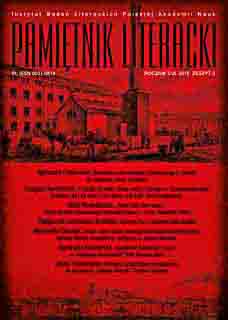„Mexicanidad” à la Wańkowicz
“Mexicanidad” à la Wańkowicz
Author(s): Beata NowackaSubject(s): Literary Texts
Published by: Instytut Badań Literackich Polskiej Akademii Nauk
Keywords: Melchior Wańkowicz; Wańkowicz's: “W kościołach Meksyku [In the Churches of Mexico]”; “W ślady Kolumba [Following Columbus]”; “King i Królik [King and Rabbit]"; “Czciciele ś-go kaktusa [Adorers of St. Cactus]"
Summary/Abstract: The article is devoted to Mexico, Melchior Wańkowicz’s great and unfulfilled fascination. The writer related to this country in his early essay “W kościołach Meksyku (In the Churches of Mexico)” which is an effect of his 1926 three months expedition taken in order to describe the conflict between the country and the Catholic Church, as well as fragments of American trilogy “W ślady Kolumba (Following Columbus)” with impression from his next journey in 1961. Traces of Mexican adventures can also be found in the correspondence between Wańkowicz and his wife “(King i Królik. Korespondencja Zofii i Mechiora Wańkowiczów <King and Rabbit. Correspondence between Zofia and Melchior Wańkiwicz>)” which is also referred to in the article. Attempting to describe the phenomenon of the Mexicanness (mexicanidad), which so much captivated the father of Polish journalism, the author of the article resorts to, inter alia, Octavio Paz’s essay (“El labiryntode la soledad <The Labirynth of Solitude>”) and to academic assumptions of Tadeusz Łepkowski collected in his “Historia Meksyku (A History of Mexico)”. Analysing autobiographical and bibliographical threads concerning Wańkowicz’s creativity, she also calls into question attributing him the authorship of a popular in The Inter War Period brochure about peyote, a psychotropic substance obtained from a plant growing in Mexico (“Czciciele ś-go kaktusa <Adorers of St. Cactus>”). Nowacka admits that Wańkowicz possessed all the characteristics to find a deep connection with Mexico, yet his fascination remained unfulfilled. He lived his life closely tied to the rhythm of 20th c. world history, so his literary passions were realised in the Revolutionary Russia, occupied Poland, Nazi Germany, and post-war America.
Journal: Pamiętnik Literacki. Czasopismo kwartalne poświęcone historii i krytyce literatury polskiej
- Issue Year: 2015
- Issue No: 2
- Page Range: 223-239
- Page Count: 17

